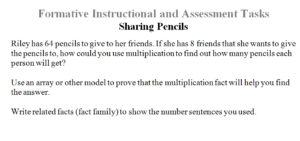Understand division as an unknown-factor problem. For example, find 32 ÷ 8 by finding the number that makes 32 when multiplied by 8.
[divider] [/divider] Students are able to…
- Describe information in problem situations and relate that information to written multiplication and division equations.
- Practice using missing factors to find the solution to the division problem. For example, to solve 42÷6, think what number multiplied by 6 equals 42.
[divider] [/divider] Students are able to…because teachers:
- Provide problem situations (“group size unknown” and “number of groups unknown”) that involve finding a missing factor for students to model and solve.
- Make explicit connections between the model, the written multiplication equation, and the related division equation.
- Include class activities that relate division to thinking about a missing factor.
[divider] [/divider] Questions to ask students:
- As students are solving division problems, ask how they could use multiplication to solve the division problem. Ask them why they are able to use multiplication to solve division problems.
- Sample answer that indicates understanding: I know that 4 x 8=32 so, 32 ÷4 =8. I can use multiplication facts to solve division problems, because they are inverse/opposite operations. In division I know the total and I am trying to solve for the number of groups or things in each group, and in multiplication I know the number of groups and things in each group, but I am trying to find the total.
- Ask students how they could represent the division problem as a multiplication equation with a missing factor.
- Sample answer that indicates understanding: To solve 32 ÷4 =?, I could use the equation 4 x ? = 32.
[divider] [/divider] FSA Notes:
Cognitive Complexity Level: 2 – Basic Application of Skills and Concepts
Achievement Level Descriptors:
2- writes multiplication equations to solve division problems with unknown factors where the factors are 1, 2, or
3- writes multiplication equations to solve division problems with unknown factors where the factors are less than or equal to 10
4- [intentionally left blank]
5- [intentionally left blank]
Assessment Limits:
All values in items may not exceed whole number multiplication facts of 10 × 10 or the related division facts.
[divider] [/divider] Additional Resources:
Additional in depth content knowledge
Post by Bill McCallum on the difference between OA.1.4 and OA.2.6
Learn Zillion Video: Interpret Division as an Unknown Factor Problem Using Arrays
[divider] [/divider] Sample Formative Assessment Tasks:
[divider] [/divider] Resources/Tasks to Support Your Child at Home:
When presenting your child with a division problem, try to ask problems related to multiplication facts they are already familiar with. Ask them to identify a multiplication fact that could help them find the missing number of groups or items in each group.
Ask your child to represent division problems with a division equation and as a multiplication equation with an unknown factor. This will encourage your child to think about how they can use multiplication facts to efficiently solve division problems.
Learn Zillion Video: Interpret Division as an Unknown Factor Problem Using Arrays
Khan Academy Video: Relating Division to Multiplication https://bit.ly/2LqRwT1

